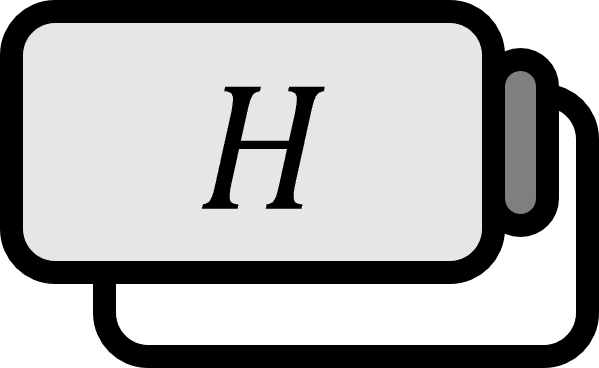Hilbert Space's Orthonormal Basis and Unitary Operator
Definition
If a Schauder basis $\left\{ \mathbf{e}_{k} \right\}_{k \in \mathbb{N}}$ of a Hilbert space $H$ is a normal orthogonal system, then $\left\{ \mathbf{e}_{k} \right\}_{k \in \mathbb{N}}$ is called the Orthonormal Basis of $H$.
Theorem1
Equivalent Conditions for Orthonormal Basis
- [1]: Assuming $H$ is a Hilbert space. For the normal orthogonal system $\left\{ \mathbf{e}_{k} \right\}_{k \in \mathbb{N}} \subset H$ of $H$, the following are all equivalent.
- (i): $\left\{ \mathbf{e}_{k} \right\}_{k \in \mathbb{N}} \subset H$ is the Orthonormal Basis of $H$.
- (ii): For all $\mathbf{x}\in H$: $$ \mathbf{x}= \sum_{k \in \mathbb{N}} \langle \mathbf{x}, \mathbf{e}_{k} \rangle \mathbf{e}_{k} $$
- (iii): For all $\mathbf{x}, \mathbf{y} \in H$: $$ \langle \mathbf{x}, \mathbf{y} \rangle = \sum_{k \in \mathbb{N}} \langle \mathbf{x}, \mathbf{e}_{k} \rangle \langle \mathbf{e}_{k} , \mathbf{y} \rangle $$
- (iv): For all $\mathbf{x}\in H$: $$ \sum_{k \in \mathbb{N}} \left| \langle \mathbf{x}, \mathbf{e}_{k} \rangle \right|^{2} = \left\| \mathbf{x}\right\|^{2} $$
- (v): $\overline{\text{span}} \left\{ \mathbf{e}_{k} \right\}_{k \in \mathbb{N}} = H$
- (vi): If $\mathbf{x}\in H$ and for all $k \in \mathbb{N}$ if $\langle \mathbf{x}, \mathbf{e}_{k} \rangle = 0$ then $\mathbf{x}= \mathbf{0}$
Unitary Operators and Orthonormal Basis
- [2]: If $\left\{ \mathbf{e}_{k} \right\}_{k \in \mathbb{N}}$ is considered the orthonormal basis of $H$, then the orthonormal basis of $H$ is exactly represented as $\left\{ U \mathbf{e}_{k} \right\}_{k \in \mathbb{N}}$ with respect to the unitary operator $U : H \to H$.
Description
Especially, it is said that all orthonormal bases of $H$ are characterized by the unitary operator $U$, similar to the result in theorem [2].
Proof
Refer to references for the proof of [1].
[2]
Let also $\left\{ \mathbf{v}_{k} \right\}_{k \in \mathbb{N}}$ be the orthonormal basis of $H$. Define the operator $U : H \to H$ as follows: $$ U \left( \sum_{k \in \mathbb{N}} c_{k} \mathbf{e}_{k} \right) := \sum_{k \in \mathbb{N}} c_{k} \mathbf{v}_{k} \qquad , \forall {c_{k}}_{k \in \mathbb{N}} \in l^{2} $$ Then, $U$ is bounded, bijective, and $\mathbf{v}_{k} = U \mathbf{e}_{k}$.
Since $\left\{ \mathbf{e}_{k} \right\}_{k \in \mathbb{N}}$ is the orthonormal basis of $H$, according to (i) $\implies$ (ii), $\mathbf{v} ,\mathbf{w} \in H$ can be represented as follows:
$$ \mathbf{v} = \sum_{k \in \mathbb{N}} \left\langle \mathbf{v} , \mathbf{e}_{k} \right\rangle \mathbf{e}_{k} \\ \mathbf{w} = \sum_{k \in \mathbb{N}} \left\langle \mathbf{w} , \mathbf{e}_{k} \right\rangle \mathbf{e}_{k} $$
Then, by the definition of $U$ and (i) $\implies$ (iii),
$$ \begin{align*} \left\langle U^{ \ast } U \mathbf{v} , \mathbf{w} \right\rangle =& \left\langle U \mathbf{v} , U \mathbf{w} \right\rangle \\ =& \left\langle \sum_{k \in \mathbb{N}} \left\langle \mathbf{v} , \mathbf{e}_{k} \right\rangle \mathbf{e}_{k} , \sum_{k \in \mathbb{N}} \left\langle \mathbf{w} , \mathbf{e}_{k} \right\rangle \mathbf{e}_{k} \right\rangle \\ =& \sum_{k \in \mathbb{N}} \left\langle \mathbf{v} , \mathbf{e}_{k} \right\rangle \overline{\left\langle \mathbf{w} , \mathbf{e}_{k} \right\rangle} \\ =& \left\langle \mathbf{v} , \mathbf{w} \right\rangle \end{align*} $$
In other words, since $U^{ \ast } U = I$, $U$ is a unitary operator, and it is bijective having the inverse operator $U^{-1} = U^{ \ast }$. Meanwhile, assuming $U$ is unitary from the assumption produces
$$ \left\langle U \mathbf{e}_{i} , U \mathbf{e}_{j} \right\rangle = \left\langle U^{ \ast } U \mathbf{e}_{i} , \mathbf{e}_{j} \right\rangle = \left\langle \mathbf{e}_{i} , \mathbf{e}_{j} \right\rangle = \delta_{ij} $$
That is, $\left\{ U \mathbf{e}_{k} \right\}_{k \in \mathbb{N}}$ is an orthonormal set. To show that it becomes the basis of $H$, let’s assume $\left\langle \mathbf{v} , U \mathbf{e}_{k} \right\rangle = 0$ for all $k \in \mathbb{N}$. Then, for all $k \in \mathbb{N}$, $\left\langle U^{ \ast } \mathbf{v} , \mathbf{e}_{k} \right\rangle = 0$, thus $U^{ \ast } \mathbf{v} = \mathbf{0}$ must hold. It was already shown that $U^{ \ast } = U^{-1}$, so applying $U$ to both sides yields $\mathbf{v} = \mathbf{0}$. Consequently, according to (vi) $\implies$ (i), it can be confirmed that $\left\{ U \mathbf{e}_{k} \right\}_{k \in \mathbb{N}} \subset H$ becomes the orthonormal basis of $H$.
■
Ole Christensen, Functions, Spaces, and Expansions: Mathematical Tools in Physics and Engineering (2010), p80-83 ↩︎
